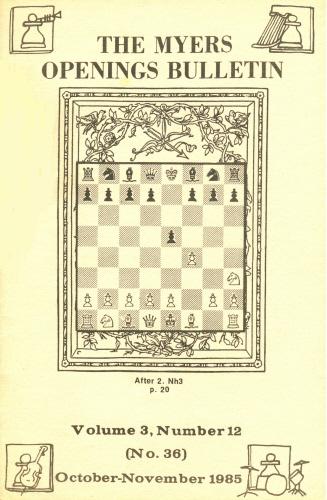
Edward Winter
First, a text we wrote in December 2008:
With the death of Hugh Edward Myers (Davenport, IA, USA) the chess world has lost a writer and opening theoretician most noted for specializing in ‘unusual’ openings. From November 1979 to December 1996 he intermittently edited and published The Myers Openings Bulletin, offering a remarkable diet of deeply-researched openings articles (no opening seemed too abstruse for consideration), historical features, book reviews and topical commentary. He included contributions from many writers who later gained prominence in their own right, and the Bulletin built up a loyal, affectionate readership throughout the world.

Myers made a particular study of the Nimzowitsch Defence (1 e4 Nc6), and wrote several monographs on it, the last one being in 1995 (published by Caissa Editions). Earlier books were New Strategy in the Chess Openings (1968), Reversed King Pawns: Mengarini’s Opening (1977) and Exploring the Chess Openings (1978). In 2002 he brought out his 239-page autobiography, A Chess Explorer. It included 130 of his games, intermingled with reminiscences, at turns comic and tragic, of his adventures and encounters. For instance, he was acquainted with Bobby Fischer and wrote on pages 42-43:
‘He won the US Championship for the first time on 7 January 1958, clinching it with a short last-round draw against Abe Turner. It was a snowy evening. I was one of the few people he would listen to (Probably because he respected my taste in openings! I don’t think he knew anyone else who owned and loved a 1956 Russian openings book by Lipnitsky, as we both did). So I was the only person to escort Fischer and his mother to the subway station. He was celebrating by throwing snowballs at passing buses! I got him to stop that, telling him he wouldn’t want to see his name in the morning papers both for winning the championship and for getting arrested.’
Among Myers’ admirable traits were independence of mind and forthrightness, and those qualities were much in evidence in 1985 when, almost alone in the chess world, he disputed the (then) commonly accepted version of the rights and wrongs regarding the termination of the 1984-85 world championship match between Karpov and Kasparov. This eventually led to his becoming acquainted with Florencio Campomanes and, as related on pages 184-194 of A Chess Explorer, he worked to ensure the Filipino’s re-election as FIDE President in 1986. Myers was a fine writer, and never were his wit and fire deployed to greater effect.
Dogged by illness and other personal difficulties, Myers played competitive chess increasingly seldom, focussing on writing whenever his health and other circumstances permitted. The four games below are taken from his last book, A Chess Explorer. The first of them became quite well known, having been annotated by Hans Kmoch on page 89 of the March 1957 Chess Review:
Hugh Edward Myers – William Lombardy
Semi-final, Manhattan Chess Club Championship, New York, 1957
Réti Opening1 g3 Nf6 2 Bg2 d5 3 Nf3 Bf5 4 c4 c6 5 cxd5 cxd5 6 Qb3 Bc8 7 O-O e6 8 Nc3 Nc6 9 d4 Bd6 10 Rd1 h6 11 a3 Na5 12 Qc2 Bd7 13 b4 Nc4 14 e4 dxe4 15 Nxe4 Rc8 16 Ne5 Bxe5 17 dxe5 Nd5 18 Qe2 O-O 19 Qh5 Qc7 20 Rxd5 exd5 21 Nf6+ gxf6 22 exf6 Nd6 23 Bxh6 Bf5 24 Bxd5 Qc2 25 Bxf8 Rxf8 26 Qh6 Ne8 27 Re1 Bg6 28 Rxe8 Qd1+ 29 Kg2 Qxd5+ 30 f3 Qd2+ 31 Qxd2 Rxe8 32 Qh6 Resigns.
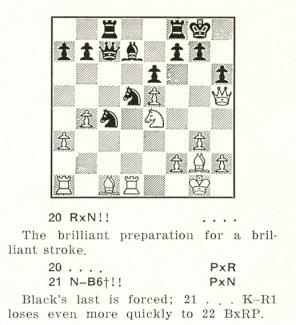
Extract from the annotations to Myers v Lombardy, by Hans Kmoch, Chess Review, March 1957, page 89
Next, a friendly contest in which Myers gave up six pawns in the first ten moves (‘I was drinking rum before and during the game’):
Hugh Edward Myers – Tirso Alvarez
Santo Domingo, 24 December 1966
Amar Opening/Paris Opening1 Nh3 d5 2 g3 e5 3 f4 Bxh3 4 Bxh3 exf4 5 O-O fxg3 6 e4 gxh2+ 7 Kh1 dxe4 8 Nc3 Nf6 9 d3 exd3 10 Bg5 dxc2 11 Qf3 Be7 12 Qxb7 Nbd7 13 Bxd7+ Nxd7 14 Bxe7 Kxe7 15 Nd5+ Kf8 16 Nxc7 Nc5 17 Ne6+ Nxe6 18 Qxf7 mate.
‘This is one of the best of all my games’, wrote Myers of his next brilliancy, which was also annotated by Kmoch (Chess Life & Review, October 1970, pages 564-565):
Hugh Edward Myers – Juan Leon
Championship of San Juan, Puerto Rico, 1969
Sicilian Defence1 e4 c5 2 Nf3 g6 3 h4 Bg7 4 h5 d6 5 Bb5+ Bd7 6 a4 gxh5 7 Rxh5 a6 8 Bxd7+ Qxd7 9 d3 Nf6 10 Rh4 Nc6 11 Nc3 O–O-O12 a5 d5 13 Na4 Kb8 14 Bf4+ Ka7 15 Nxc5 Qe8 16 Bc7 Rc8 17 Bb6+ Ka8 18 Qe2 dxe4 19 dxe4 Nd7 20 Nxa6 bxa6 21 Qxa6+ Kb8 22 e5 Rc7 23 Bxc7+ Kxc7 24 e6 fxe6 25 Ng5 Qg6 26 Rc4 Ndb8 27 Qb6+ Kd7 28 Rd1+ Ke8 29 Qxb8+ Resigns.
The noted authority Ariel Mengarini praised the final game:
Hugh Edward Myers – B. Devin
US Open, Chicago, 1973
Sokolsky Opening1 b4 c6 2 Bb2 Qb6 3 a3 a5 4 c4 axb4 5 c5 Qc7 6 axb4 Rxa1 7 Bxa1 d5 8 Nf3 f6 9 e3 e5 10 Be2 b6 11 O-O bxc5 12 bxc5 Bxc5 13 d4 Bd6 14 e4 Ne7 15 Nc3 exd4 16 Qxd4 c5 17 Qa4+ Bd7 18 Nb5 Bxb5 19 Bxb5+ Kf8 20 exd5 Nxd5 21 Re1 Be7 22 Qe4 Nf4 23 Ng5 g6 24 Qxf4 Resigns.
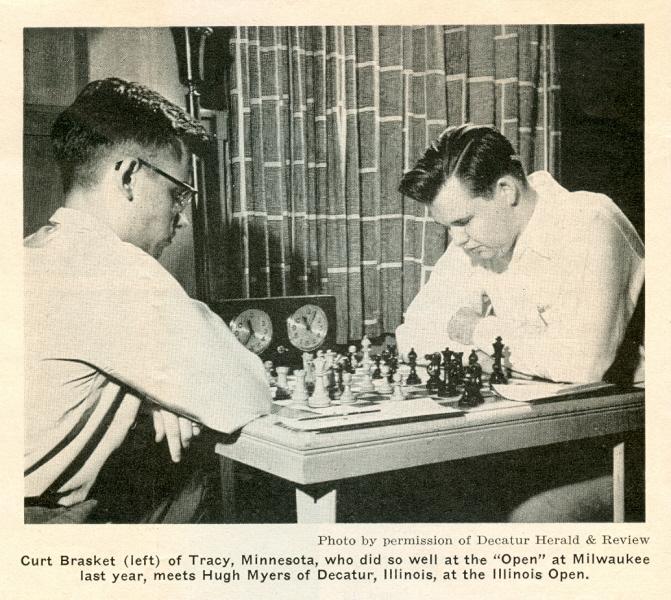
From Chess Review, February 1954, page 36
Hugh Myers was a true chess lover, and a lover of chess truth.
***
The above tribute by us was published anonymously at ChessBase on 25 December 2008. It was followed by an appreciation of Myers by the Editor of Kaissiber, Stefan Bücker.
From Copying:
A website which has often taken scans of ours without permission is ‘Tartajubow On Chess’. The site finds it easy to lift pictures but less so to spell names. An example, concerning Hugh Myers:
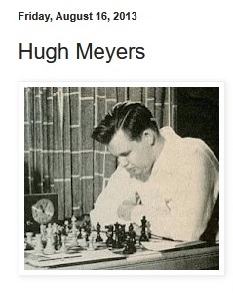
There follows a selection of C.N. items in connection with Hugh Myers.
***
We have been perusing the 25th issue of the Myers Openings Bulletin (October-November 1982). The contents are highly original; we enjoyed the sharp writing style and did not particularly mind those passages which exemplified Myers’ words on the first page, ‘We are poor but not humble’. The book reviews of openings literature are especially fine.
(381)
Recent perusal of the run of this magazine convinces us that it is one of the greatest independent chess magazines available, if not the best of them all. Myers has a highly developed intelligence and sensitivity, combined with a remarkable level of chess erudition which is by no means limited to the openings. His pleasant, open personality gives the Bulletin a charming style.
(499)
From Hugh Myers (Davenport, IA, USA):
‘Robert Snyder published a booklet The Snyder Sicilian in which he dared to name 1 e4 c5 2 b3 after himself. As I pointed out in the Myers Openings Bulletin, that was played by Cochrane against Staunton, and later in major competition by Kieseritzky and L. Paulsen. Then in this century it was practised by Czerniak; he published analysis of it in the 1940s, and it has his name. Then Snyder did it again, continuing to name the opening after himself in a larger book. Worse is that US magazines such as Chess Life and the Chess Correspondent publish his writings, without editing his claims.’
Hugh Myers has consistently argued – with great force – against those who name chess openings after themselves, and we go with him all the way.
(799)
Hugh Myers writes:
‘I reject the casting of all blame on Alekhine for there not having been a Capablanca rematch. See the Myers Openings Bulletin number 33, page 25. Earlier than 1938 I’m sure that there would have been a rematch if Capablanca had simply come up with 10,000 dollars in gold – and why should that have been impossible, even during the Depression, at a time when many people still believed that he was the strongest player of all time?’
(801)
And:
‘I’m tired of reading things like the following quotes written by people who don’t know enough about chess history to say anything about it (and they weren’t the first): “Alekhine used every possible pretext to avoid playing a match with anyone who might have presented a real danger to him. Thus, Capablanca, the logical choice for a rematch, was kept at a distance by means of insults and impossibly high financial demands” (J. Marfia, 1981), and “(Alekhine) used his friendship with Capablanca to contract a world title match ahead of more qualified candidates, and following his win, he avoided a return match” (J. Graham, 1984). However – Alekhine accepted Capablanca’s challenge to a return match, under the same conditions as their 1927 match (BCM, January 1930). In The Times (London) of 11 August 1930, Tinsley reported on a contact with Capablanca. Negotiations for the match – for the same stakes as in 1927 – had been suspended. Capablanca hadn’t been able to come up with the money; he hoped to raise it in the U.S in late 1930. That doesn’t conflict with the 9/30 Deutsche Schachzeitung report, except that the October 1929 500 dollars deposit shouldn’t be called a “stake”; that was just a deposit towards the stakes to show the sincerity of the challenge that the BCM reported in 1/30. Actual stakes would have to have been $10,000 dollars, or perhaps £2,000.
Capablanca repeated his challenge in February 1931, first asking for a match in the Spring, then for one in the Winter of 1931-32. Considering that he was to blame for the match not occurring in 1930, he was very arrogant to tell Alekhine that he was going to reclaim the title by default if his challenge was not accepted. But Alekhine did accept it again, under the London Rules of 1922, as Capablanca had demanded (BCM, April 1931). Unfortunately the negotiations fell apart during the next few months. Why? Mutual dislike? Capablanca’s inability to raise the stakes? Recognition that he probably couldn’t defeat the Alekhine of 1930-31 (the years of his greatest triumphs, at San Remo and Bled)? Or just Alekhine’s annoyance with what Capablanca had written? In any case, I don’t think Capablanca was free of blame for not getting a rematch. That is emphasized by what I wrote in MOB issue 33: Alekhine accepted Capablanca’s challenge in 1938, and that match didn’t happen because Capablanca’s backers in Montevideo backed out.’
(918)
Hugh Myers has been reading American Chess Masters from Morphy to Fischer by Arthur Bisguier and Andrew Soltis (New York, 1974) and quotes three snippets:
a) From the Preface, regarding Hermann Helms: ‘He played on the same Brooklyn Chess Club team as his good friend Harry Pillsbury and once defeated Frank Marshall twice in a New York State championship game.’ Our correspondent would like to know the Helms method for scoring two points from one tournament game.
b) Page 76, concerning Pillsbury in 1905: ‘He tried to commit suicide by jumping from the fourth floor of a Philadelphia hospital where he was being treated for mental disorders.’ Mr Myers comments: ‘I haven’t read that elsewhere. The fourth floor! If true, couldn’t a fall like that have been a factor in his death (“apoplectic seizure”) in 1906, and not simply syphilis, as has been alleged?’
c) Hugh Myers writes:
‘On pages 88-89 there is something that is too typical of master annotation. About the game Marshall-Atkins, Cable Match 1903, the co-authors say after move 24: “Black (Atkins) had played very effectively in the opening and held a considerable advantage ... White’s premature attack is repulsed.” Then Marshall played “25 P-N3!!” – “an ingenious attempt at swindle'. Marshall went on to win. They point out that annotators Mieses and Pachman didn’t understand the position, but that Marshall wrote how the game might have been drawn by the best response. So if Black had at best only a hard-to-find (and not certain) draw, why was White’s attack “premature”? And why did Atkins lose (or have only a possible draw with difficult play) if he “held a considerable advantage”??’
We add just two brief comments. 1) Once again there is the old problem of what Marshall wrote being what Reinfeld wrote. 2) At the end of the first paragraph on page 89 Bisguier and Soltis speak of a mate threat which does not exist.
(997)
From James J. Barrett (Buffalo, NY, USA):
‘In C.N. 997 Hugh Myers wondered how Pillsbury survived jumping out of the hospital window. The answer, of course, is that he “attempted to throw himself out of the window”, as Ludwig Bachmann is quoted as writing in 1914 by Walter Korn’s excellent America’s Chess Heritage (page 71).’
Mr Myers himself recently pointed out to us that on page 51 of The US Chess Championship, 1845-1985 by McCormick and Soltis it is specified that Pillsbury only tried to jump. We imagine that this is what Bisguier and Soltis meant on page 76 of American Chess Masters from Morphy to Fischer, but it is not what they wrote.
(1272)
Ken Whyld (Caistor, England) writes:
‘James J. Barrett refers, in C.N. 1272, to Korn’s “excellent” America’s Chess Heritage. I found much to admire in the book, but there are too many blunders to call it excellent. For example, in a section on women’s achievements page 267 gives a substantial account of Mrs W.J. Baird’s creditable (for a woman) next to last place at New York, 1889. Quite apart from the fact that I find the patronizing tone of this section offensive, it was David Washington Baird who landed in that spot while David Graham Baird finished nearer to the middle.’
(1310)
See too Pillsbury’s Torment.
We have asked Hugh Myers for his views on the validity of casual games in opening theory and on why older games are so often ignored by theorists. His reply:
‘Openings from simuls – just as from skittles, speed chess, computer games – anything at all – might have value. It’s the moves that count. If a variation is new, and it’s at least as good as something that has already been published, its source is irrelevant. Of course it’s less likely that an opening will be significant when played in a simul or a blitz game, as compared to a tournament game played by professional players, but a weakness of most openings books is an ignoring of sources other than grandmaster games. This indicates a lack of self-confidence by the writer (not wanting to evaluate games of minor players), or perhaps insurance against error (if a line is proven to be no good, the writer can excuse himself by pointing to the category of the person who played it). A writer may ignore old games because he wants his book to look as up-to-date as possible, or because names of current GMs impress buyers. Mostly it’s a question of laziness combined with being in a hurry to get the book published that limits a writer’s research of old sources (maybe the sources are just unavailable to some writers, but some writers shouldn’t attempt to write openings books). There is also an element of contempt for old sources – but I repeat: some writers shouldn’t write’.
(1006)
Jokey opening names are often tiresome and inapposite, but there is no shortage of these strained attempts at humour, which are about as welcome as a hole at g7. The ‘Hippopotamus Opening’ from the 1950s has a suitably muddy history (well traced by Michael Macdonald-Ross in issue 14 of the Myers Openings Bulletin), but we recently chanced upon a much earlier use of the name, on page 183 of the 1916 BCM. There it is reported that the Revue suisse d’échecs referred to Alapin’s Opening as ‘the Hippopotamus’; ‘decidedly good!’, writes the BCM inexplicably.
(1101)
Hugh Myers (Davenport, IA, USA) points out that the following appeared on pages 17-18 of the Myers Openings Bulletin, issue 22:
‘The first use of Hippopotamus for an opening seems to have been in the 15 June 1876 issue of the American Chess Journal. It gave this game, which it said was from volume five of the Neue Berliner Schachzeitung: 1 e4 e5 2 Ne2 Qh4 3 Nbc3 Nc6 4 g3 Qg5 5 d4 Nxd4 6 Bxg5 Nf3 mate. The American writer’s comment was, “You should call 2 Ne2 the Hippopotamus Opening!” That sarcasm didn’t discourage Alapin – if he ever saw it. He does seem to be the one master who played it often, and 2 Ne2 is known by his name.’
(1155)
Ken Whyld (Caistor, England) sends us a photocopy from the Neue Berliner Schachzeitung, February-March 1868, pointing out that ‘the article is a “chess humoresque” and itself contains the dig that the “matator” should baptize his exquisite opening the Hippopotamus Game’.(1193)
Below is the complete text of C.N. 1457 (a letter from Mr Evans and our reply, published in 1987):
From Larry Evans (Reno, NV, USA):
‘Thanks for the complimentary C.N. 33. I always enjoy reading it, although the twisted logic and pro-Campo slant often detract from your admirable qualities. One is tempted to wonder if Campo has bought you off too, as he did by giving Hugh Myers (one of his only defenders in America) the job of bulletin editor at Dubai.
Re C.N. 1385: memory plays tricks. I recalled Prins winning a hopeless adjournment from Quesada, who died before the game could be finished. I no longer have the scoretable of Havana 1952 but if Prins says he resigned, far be it from me to quibble. I stand corrected even though you must admit it makes a good story.
But you are unscrupulous to deduce that I am defaming the character of Capa, Alekhine and Euwe merely because I made the perfectly banal observation that dragging out hopeless positions does “not endear a master to his colleagues”. I wasn’t even thinking of the trio you dragooned out to discredit me. If I have something negative to say about any of the world champions, I can do it myself without your putting words in my mouth.
I have noticed that almost every reference to me in C.N. is critical. In C.N. 1393 you take me to task for awarding a prize to a Chess Life reader who found that 40 h5 wins in the game Capa-Fine. This “discovery” is mentioned in Heidenfeld’s book Draw! but it in no way detracts from the stunning shock value of this missed win – only one reader pointed out it was not new. Fine himself appears unfamiliar with 40 h5! since his Lessons From My Games was reprinted in 1958 as A Passion for Chess and still does not contain this correction.
Finally, here is a 6,000 word news story which is critical of that thug who currently is president of FIDE. You are welcome to publish portions in full, although probably you will find a way to pick it to shreds by taking things out of context. Go to it – if you can! – it seems to be your customary style.
Meanwhile I hope you keep your curmudgeonly watch on the chess world. C.N. is unique and lively. Incidentally, one of the reasons Seattle lost out to Seville is that a lot of prize money was structured as “best game prizes” so Campo could not get his greedy hands on it.
Will you publish this in full? I wonder.’
1. The above is indeed the full text of Mr Evans’ letter.
2. He does not explain what he means by ‘twisted logic’ or ‘pro-Campo slant’. We have never been ‘bought off’ by anybody and never shall be.
3. The Prins-Quesada episode is not ‘a good story’ once it is shown to be untrue. Mr Evans accuses us of being unscrupulous, dragooning out a trio, putting words in his mouth, etc., but how could he overlook that in C.N. 1385 the writer is Lodewijk Prins? Or that what Mr Prins wrote bears no relation to what Mr Evans claims was written? Nobody has suggested that Larry Evans was ‘defaming the character of Capa, Alekhine and Euwe’; Mr Prins simply pointed out that even those three world champions had played on – legitimately – when behind on material. Mr Evans’ inability to read plain English is remarkable.
4. Most C.N. references to Mr Evans have indeed been critical, but they have also been carefully documented; until now he has never replied, despite our giving him the opportunity by sending him complimentary copies of issues in which he was mentioned. It would have been fascinating to have his answer to, for instance, C.N. 1192, where we criticized him for writing, ‘Whether GM Karpov was right or wrong, I believe that posterity will remember him mainly for ducking Fischer’. That, incidentally, is the same Larry Evans who wrote on page 10 of The Chess Beat: ‘It looks like Fischer has been ducking Karpov, not the other way around.’
5. The purpose of C.N. 1393 was to obtain information about the Capablanca-Fine position, and our only criticism of Mr Evans (made in a subordinate clause) concerned the illogicality of suggesting that 40 h5 could be called an ‘amazing discovery’ now even if it had been found before. We quoted the position only after waiting in vain for several months in case Chess Life readers came up with any details. Further carelessness in Mr Evans’ letter (and in the August Chess Life): his bibliographical details on Fine’s book are wrong.
6. The taking-out-of-context accusation. Readers with a good memory for trash will recall that an associate of Mr Evans’, Mr Larry Parr, made a similar suggestion in C.N. 1143. Neither, of course, has ever provided a single example to back up the claim.
7. The credibility of Mr Evans’ insultingly worded challenge to us to quote from his 6,000 word article (which mainly concerns US chess politics) is undermined by the fact that two days later he sent us a second letter saying that the exclusive European rights to the article had been sold to New in Chess and that for now we could not, after all, quote anything. We are glad that this second letter reached us: with Mr Evans’ characteristic eye for detail, it was addressed to ‘William Winter’.
8. His ‘Incidentally ...’ sentence in the penultimate paragraph is not relevant to anything that has appeared in C.N., though it serves as a further example of his crudity.
9. As regards the ‘dare’ in the last sentence of his letter, it is rather pathetic that he imagined that publication of his mishmash of hunches, blunders and scurrilities might prove awkward for anyone other than himself.
Mr Evans’ letter was dated 17 June. On 23 June we confirmed to him that we would indeed publish it in full, not least because it offered perfect justification of our criticisms of him. We gave detailed examples of how we should be replying in C.N. (along the lines of our points made above). Nonetheless, as a gesture, we also told him that if he apologized for his factual errors and unfounded attacks we would be prepared to keep his foolish letter private. ‘It is entirely up to you’, we added.
On 6 July Mr Evans replied: ‘I’m willing to let it remain a private matter and drop it in print, if this suits you. This is in no way an admission that I agree with any of your points ...’ If it suited us!! Despite his sudden loss of enthusiasm for having his letter published, Mr Evans did not offer the apology we had requested. The closest he came was in saying ‘It may be unfair to equate you with the Campo group ...’ and ‘I may have been a bit hasty in accusing you of being bought by Campo ...’
Mr Evans has been ‘unfair’ and ‘a bit hasty’ about far more than that. If he wants further rope in our next issue, he has only to write again.
(1457)
From Hugh Myers (Davenport, IA, USA):
‘I supported the re-election of Florencio Campomanes as President of FIDE, just as did about 80% of the national federations which belong to FIDE. If it’s true, as Evans said, that I was “one of his only defenders in America”, then I’m complimented by his recognition that I was able to resist the brainwashing that was imposed on American players by a chess press that was monopolized by biased writers and editors such as Evans, Goodman and Parr. Evans dares to use the words “twisted logic”, knowing that I had applied them to the writing of his group’s leader, Raymond Keene, in 1985.
It’s very easy to show that Evans is wrong when he says that I was “bought off” by Campomanes, allegedly having been paid for my support with the job of bulletin editor at the Chess Olympics in Dubai.
The first time I ever had any kind of contact or communication with Campomanes was in April 1986, when he asked about the subscription rates to my magazine, The Myers Openings Bulletin. My criticism of his political opponents was published in CHESS, Chess Notes and my magazine during 1985. In August 1986 B.H. Wood published in CHESS several other critical letters I had sent him in 1985 (even though one said he had permission to do so only if he would print one that criticized something he had published by R. Keene – and he omitted that letter!). My published criticism, and indirect support of Campomanes, started at least a full year before April 1986.
Many people know that I actively assisted Campomanes in Dubai. But it’s clear that my support was not bought by a job there; he had my support before I met him and before I had any thoughts about Dubai. He would have had it in any case.
I was hired to be editor of the Olympic bulletins by M. Ghobash, the President of the United Arab Emirates Chess Federation. I have a letter to that effect, signed by him. My name never appears in those bulletins. I went to Dubai, and did the preparatory work for their publication. Just before the Olympiad, and never with any excuse or explanation, Ghobash replaced me as editor (with his nephew!). Campomanes had given me a recommendation, but he did not give me that job. When I lost it, I asked him if he could intervene on my behalf. And he could not do anything about it.’
(1492)
After a break of about 18 months, the Myers Openings Bulletin is to resume publication in February 1988, Hugh Myers informs us ...
This exceptionally penetrating magazine has been sorely missed.
(1516)
Deserving a place in every chess lover’s refuse dump is Unorthodox Openings by Eric Schiller and Joel Benjamin (Batsford), which has been brilliantly demolished in issue 39 of The Myers Openings Bulletin. A brief quote from the magazine’s 16-page review:
‘It’s frustrating to see the chess public being exposed to book after book written by people who are negligent, or lazy, or prejudiced in their research. An unsound rating system bestows the titles of Master or Grandmaster; knowledge of chess history, and of openings they don’t play, does not automatically accompany those titles. But are the writers any more to blame than the publisher? Or a reviewer in BCM who writes unthinking praise? Or a bookseller like the USCF that hypes the books it sells to its own members?’
(1629)
In 1987 Batsford brought out Unorthodox Openings by Joel Benjamin and Eric Schiller. In the section on Nimzowitsch’s Defence (1 e4 Nc6) the authors wrote (page 50):
‘Myers, Harding and Westerinen have all written books on the subject. Westerinen’s is the best, but very hard to find.’
In the April-May 1988 issue of The Myers Openings Bulletin (page 16), Hugh Myers commented:
‘Hard to find! I should say so. I’ve never seen it, and other theoreticians have told me that they don’t know of it. I have seen a book by Westerinen titled Nc6! – it has nothing to do with 1 e4 Nc6 ... You don’t really think that Benjamin and Schiller would have judged a book as “best” without ever seeing it!?’
In the January-March 1993 issue of the same magazine, Myers reported that in 1988 Schiller, then temporarily in Hawaii, had insisted that a book on 1 e4 Nc6 by Westerinen did exist, and that a copy was in his library in Chicago. He promised to give Myers further information upon his return home. The remainder of the episode is easily guessed. Schiller kept silent and Myers eventually secured a copy of the book by Westerinen. It was published in Swedish in 1972 (also in Finnish the same year, under the title Rc6!?) and dealt only with 1 d4 Nf6 2 c4 g6 3 Nc3 Bg7 4 e4 d6 5 f3 O-O 6 Be3 Nc6.
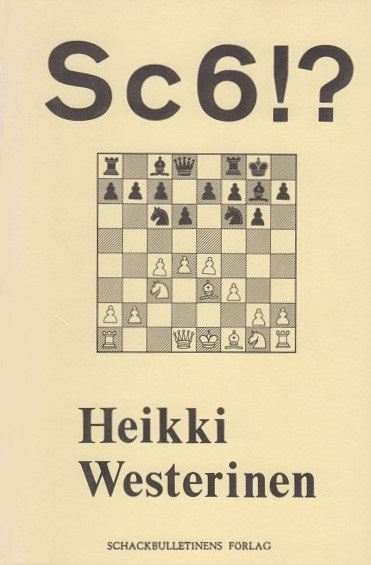
(Kingpin, 1993)
Below are the cover page and title page of our inscribed copy of the original Finnish edition:
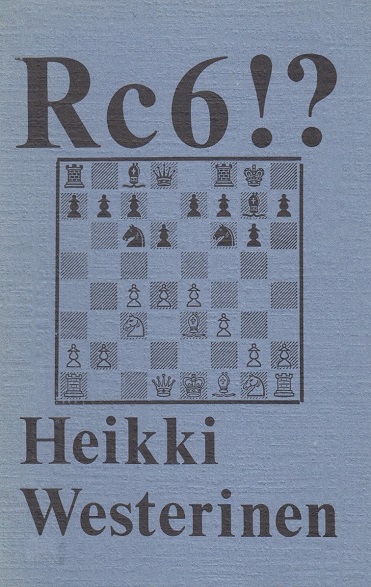
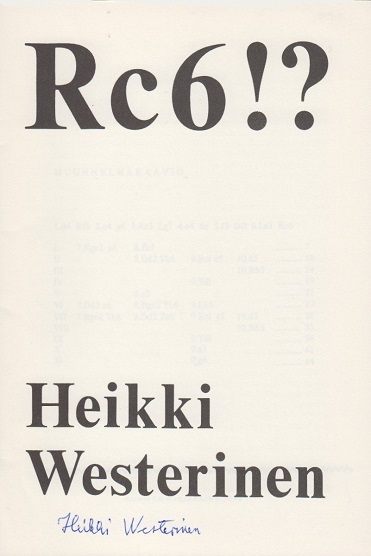
In C.N. 9493 Thomas Ristoja (Helsinki) reported that he had translated the booklet from Finnish into Swedish but that his name was omitted from the Swedish edition. The same C.N. item showed the relevant passage from page 50 of Unorthodox Openings by Benjamin and Schiller:
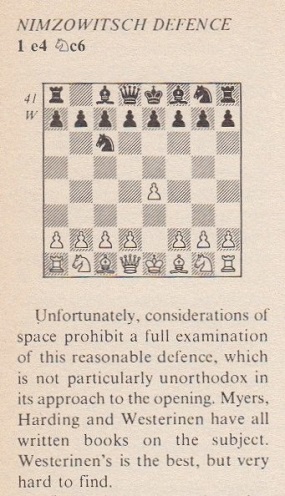
The death of our close colleague and friend Hugh Myers is a grievous blow. At present, we simply reproduce for the public record the autobiographical details which he sent us on 18 November 1983 (C.N. 635):
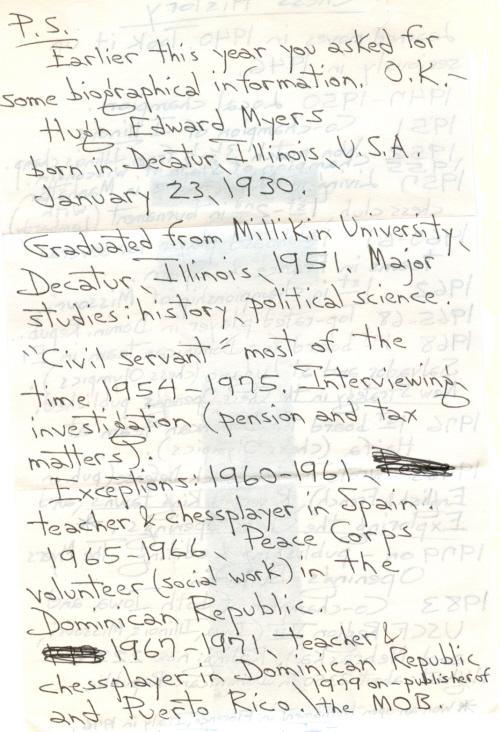
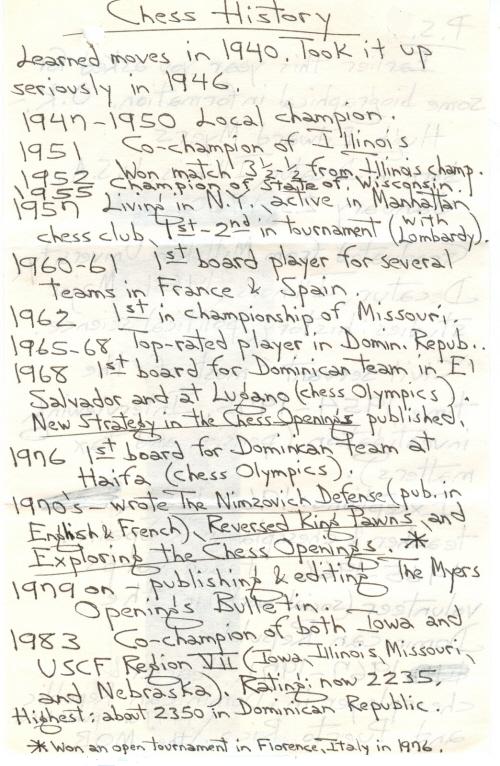
(5909)
It is impossible not to have misgivings, both general and particular, about Wikipedia, but we have recently noticed a great improvement in some of the chess articles in the site’s English-language version. There is, for instance, excellent treatment of G.H.D. Gossip, and it is also good to see a fine article on Hugh Myers.
(5919)
Both articles were written principally by Frederick S. Rhine.
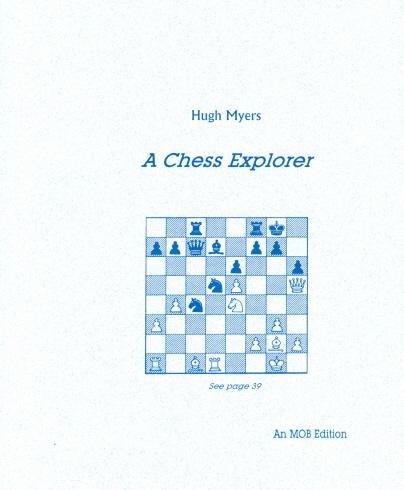
Hugh Myers’ book A Chess Explorer was published in 2002, and the following year he sent us a copy of a handwritten 12-page supplement which included a letter to him dated 4 March 1954 from Max Euwe. The former world champion commented, ‘your games are excellent and I hope to publish at least one of them in Ch. Arch.’. Myers wrote in 2003 that he was not sure which of his games he had submitted to Euwe. Did any of them appear in Chess Archives?
(6031)
Are any readers aware of an index to the Myers Openings Bulletin, which was produced on an irregular basis by Hugh Myers from November 1979 to December 1996?
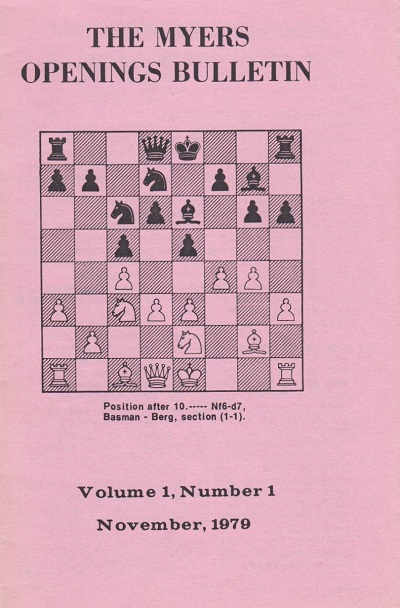
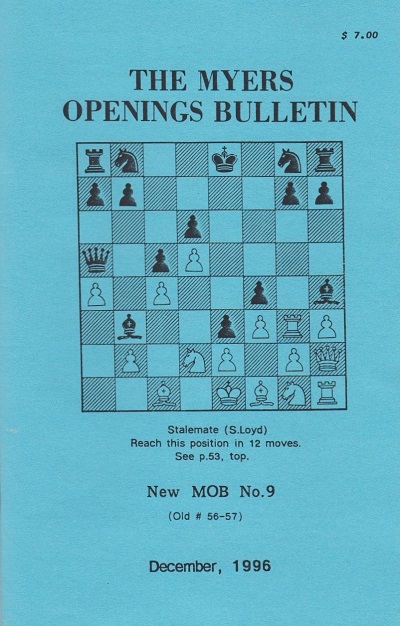
Although the main focus was on unusual openings (the first issue began with an article on 1 a3), the magazine offered much else too, including frank, authoritative book reviews and clear-sighted scrutiny of topical issues. In the final edition, pages 45-49 discussed women’s chess, and a sample paragraph follows, from page 46:
‘A couple of truths are undeniable: there is more than muscular strength to distinguish men from women, and women don’t play chess as well as men. Before the feminist hordes descend, note that I said “don’t”, not (necessarily) “can’t”. This may not be the same everywhere, but a generous estimate is that not over 5% of rated players are female. The difference is more pronounced at the top, where only one woman (Judit Polgar) is in the top 100 players; I think she is the only one who has ever been. As for quality of play, how many books have you seen that are the “best games” of particular women? Which openings are credited to women? You might say it just shows their good taste, but since the MOB started in 1979 not one woman has ever paid me for an MOB subscription, except as a gift for someone else.’
Myers then discussed some theories and scientific studies on the difference between male and female chessplayers. As ever in such cases, reading the full article is recommended.
(9387)
From our feature article The Chess Opening 1 h4:
A game on pages 13-14 of Exploring the Chess Openings by Hugh Myers (Davenport, 1978) began as follows:
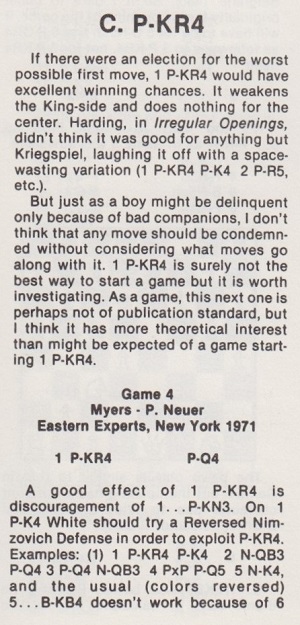
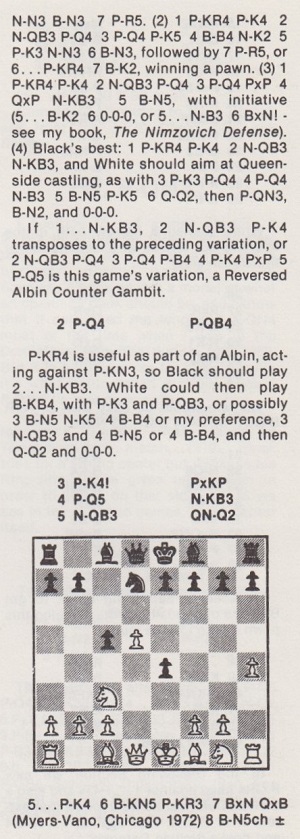
The full score from the book:
1 h4 d5 2 d4 c5 3 e4 dxe4 4 d5 Nf6 5 Nc3 Nbd7 6 Bg5 h6 7 Bxf6 Nxf6 8 Bc4 a6 9 a4 Bg4 10 Qd2 g6 11 Nge2 Bg7 12 Ng3 Qc7 13 Qe3 O-O 14 a5 Rac8 15 Ngxe4 Nxe4 16 Qxe4 Bf5 17 Qe2 Qf4 18 Nd1 Rfe8 19 c3 e6 20 Ne3 exd5 21 Bxd5 Re7 22 g3 Qe5 23 Qf3 h5 24 O-O Bh3 25 Rfe1 Qc7
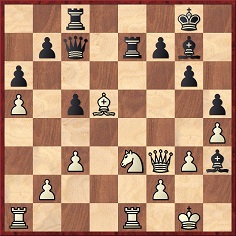
26 Nc4 Bg4 27 Rxe7 Qxe7 28 Qe3 Re8 29 Re1 Qxe3 30 Rxe3 Rxe3 31 fxe3 Be2 32 Nd6 Be5 33 Ne4 Bf3 34 Kf2 Bxe4 35 Bxe4 Bc7 36 Bxb7 Bxa5 37 e4 Kf8 38 Bxa6 Ke7 39 Kf3 Bc7 40 g4 hxg4+ 41 Kxg4 Kf6 42 Bc4 Bd6 Drawn.
The sole 1 h4 game given on page 69 of Irregular Openings by T.D. Harding (Dallas, 1984) was between unnamed players, and no particulars were provided except for ‘a recent London League game’.
On 15 September 2002 Hugh Myers (Davenport, IA, USA) sent us his win against Jason Juette in Iowa City earlier that month:
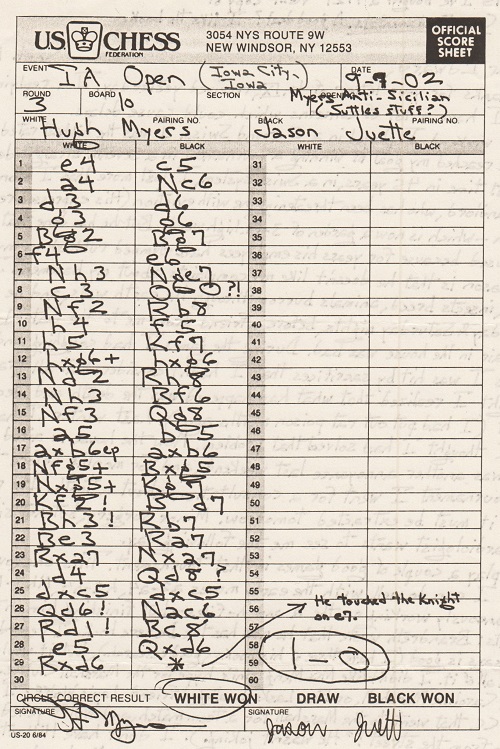
1 e4 c5 2 a4 Nc6 3 d3 d6 4 g3 g6 5 Bg2 Bg7 6 f4 e6 7 Nh3 Nge7 8 c3 O-O 9 Nf2 Rb8 10 h4 f5 11 h5 Kf7 12 hxg6+ hxg6 13 Nd2 Rh8 14 Nh3 Bf6 15 Nf3 Qg8 16 a5 b5 17 axb6 axb6 18 Nfg5+ Bxg5 19 Nxg5+ Kg7
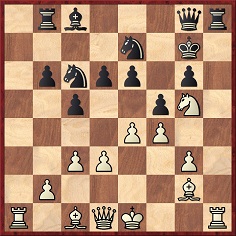
20 Kf2 Bd7 21 Bh3 Rb7 22 Be3 Ra7 23 Rxa7 Nxa7 24 d4 Qd8 25 dxc5 dxc5 26 Qd6 Nac6 27 Rd1 Bc8 28 e5 Qxd6 29 Rxd6.
Overleaf, Hugh Myers, who was aged 72 at the time, commented to us that the game ‘... shows again that I can do well with the early moves a2-a4, h2-h4, Nh3-Nf2-Nh3, and then simultaneously working on the a and h-files – but finishing him on the d-file’.
(11852)
See also The 1986 FIDE Presidential Election, which includes the ten FIDE Facts sheets (all written by Hugh Myers), as well as The Termination and The Nimzowitsch Defence (1 e4 Nc6).
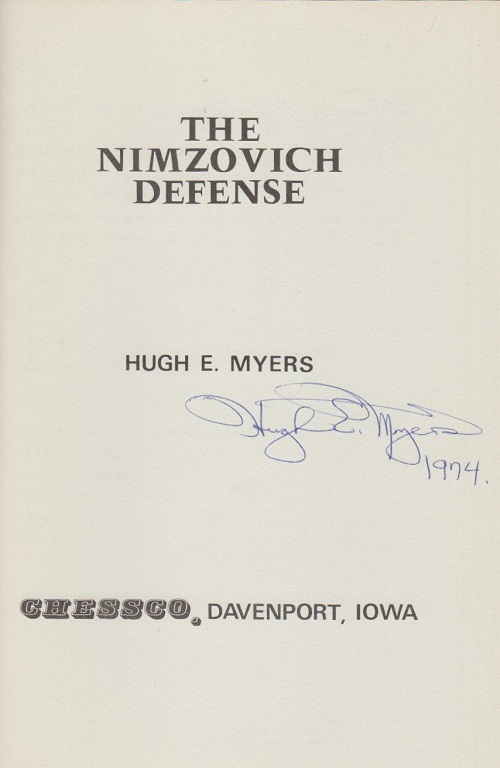
See too the contributions to C.N. by Hugh Myers concerning Warriors of the Mind.
Addition on 28 October 2024:
Below is a letter sent to us by Hugh Myers on 28 May 1999 regarding a review by Kenneth Whyld of Kings, Commoners and Knaves in the May 1999 BCM:


To the Chess Notes main page.
To the Archives for other feature articles.
Copyright: Edward Winter. All rights reserved.